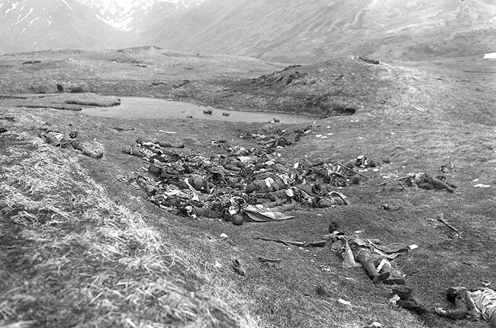
Our third installment will find both sides trading fire as they begin to spot one another. This is a common trend in Lock ‘n Load games, and is one that you must take into consideration. As soon as you fire on the enemy, you’re now spotted and open to take return fire yourself. Last time we covered how-to conduct DFT combat, so we will not cover that in such extensive detail but rather try to cover some more ground. And this introduction would not be complete without…
Note: All components seen are playtest material, and have been poorly constructed and put together by yours truly, so they do not represent what the final game will look like.
Trading Fire
A barrage of bullets opens up as the Japanese try to inflict greater damages on the loan Marine squad that rushed into the open, however as their attack is uncoordinated they have no effect. Both sides continue to open up with ill effect; each side firing upon the other one after another. The cover of heavy jungle negates the majority of each sides attempts to bring about any meaningful results.
However, as the ensuing chaos is erupting between each side a dedicated and trained Japanese sniper is setting up. He deploys and settles into his Spider Hole and takes aim at the shaken Marine squad attempting to rush his fellow countrymen. Lets look into sniper specific rules, deployment and specifics to the Heroes of the Pacific module.
11.4 Snipers
Snipers have no movement allowance … Once the scenario starts, the Sniper’s owner can place the Sniper at any time in any hex who terrain has a positive TM.
Once placed the Sniper cannot move. The Sniper can immediately attack any spotted enemy hex within its LOS utilizing the DFT table.
Japanese Snipers
Japanese Snipers are placed as per 11.4. Additionally, whenever the Japanese player places a Japanese Sniper in Kunai Grass, Heavy Jungle, Light Jungle, Brush, Clear, or Hill terrain, he may also place a Spider Hole in the hex. Since Spider Holes provide a positive modifier, this allows Japanese Snipers to be placed in Clear and Hill terrain. Only the Japanese spider that spawned with the Spider Hole may use it. If the Sniper is eliminated, the Spider Hole is removed.
This enables the Japanese Snipers to be placed in clear or hill terrain, something that was not initially possible in other modules (to my knowledge), as the Spider Hole provides the requirement for the Sniper to be placed in a positive TM hex. Let’s take a look at how they function.
The Sniper takes aim and sends rounds down range. However, while the Sniper conducts combat on the DFT table as other squads do, he gets to roll TWO six-sided die and add both die instead of just one like other units. Look below for the specific rule.
11.4 Snipers (continued)
The Sniper, however rolls 2d6 for its attack instead of 1d6. If there are multiple units int he target hex, randomly determine which target the Sniper attacks. The Sniper’s attacks only affects one unit.
We conduct our roll, and receive a 12 + 1 (target squad is marked “Moved”) for a 13. Due to being out in the open, the squad’s defense roll is a straight 1d6, which results in a 1. Their damage check roll results in a 1d6 (6) + 12 for 18! This is more than triple their morale and so the Shaken full squad is eliminated. A very unfortunate result for the Allies.
Note: it was at this point that I realized I had messed up and had not counted Marshes as degrading, which would have voided my above result. I should have incurred a -2 modifier on my attack for two degrading hexes.
Combat continues with both sides exchanging barrages of bullets with no effect. This is until our fearless Japanese leader, in G1, opens up on the Allied hex containing their Hero. They concentrate their fire and wound the Hero who is flipped to his wounded side. One more wounded result and he is eliminated.
Speaking of Heroes – the squad with the Hero (not a requirement for Hero generation) manages to roll a 1 on their Damage Check die roll. Let’s briefly cover the topic…
Hero Creation/Generation
5.1 Direct Fire Table (DFT) Results: Hero Creation
There is a chance that a Hero is created during play whenever a Squad or Half-squad (even if Shaken) rolls a 1 during a Damage Check caused by enemy fire. Roll 1d6. If the result is even, a Hero is created in the hex … The Hero assumes the activation state of the Squad that spawned it.
We roll for Hero creation and get an odd result. No additional Hero for the Allied, which would have brought them up to their limit (only two Heroes per nation on the board at any time). That concludes the action for the first turn. Lets recap where we are leaving off.
Aftermath:
- The Japanese have taken suffered three squads being reduced to half-squads
- The Japanese had both of their Ninjutsu Movement attempts fail miserably
- The Allies have lost a squad, and their only Hero is wounded
- The Allies have used one of their two 105mm Off-Board Artillery
And that’ll be a wrap for this installment. We’ve concluded the first turn of the scenario, and next will cover how-to conduct the Rally Phase, though we currently have no Shaken squads that need to attempt to Rally however we’ll cover the process. We’ll also get into some more Heroes of the Pacific features including a personal favorite of mine, the Banzai Attack!

For quick reference, below are links to our previous installments:
Thanks for reading,
– J